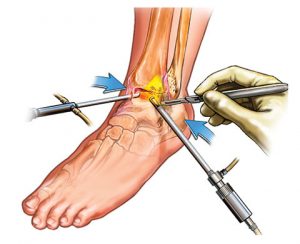
Ankle Arthroscopy
Ankle Arthroscopy
Introduction
Ankle arthroscopy is a surgical procedure that uses a fiber-optic viewing camera and small surgical tools to operate in and around the ankle joint through small incisions. Ankle arthroscopy is performed for the surgical evaluation and treatment of a variety of ankle conditions. Arthroscopic surgery can have a quicker recovery time than traditional open surgery.

You may need ankle arthroscopy if you have debris in your ankle from torn cartilage or from a bone chip. Also, if there is ligament damage from a severely sprained ankle, a bone surgeon may choose to do an arthroscopy to evaluate the extent of damage and possibly to repair it.
For some people, arthroscopy means a speedier recovery, less scarring, and fewer complications than open surgery.
Ankle Arthroscopy Preparation
In general, you should refrain from eating or drinking the day of the surgery. Check with your surgeon regarding prescription medications and herbal medications that you may be taking. The surgeon may ask you not to take blood-thinning agents such as aspirin or warfarin (Coumadin) for a few days prior to the surgery. Arrange for transportation home after the procedure if it is an outpatient procedure.
During the Procedure
You will be brought to the operating room and prepped for anesthesia and surgery. An IV line will be started. The ankle, foot, and leg will be exposed, cleaned, and sterilized. Depending on the type of anesthesia chosen, a tube may be placed in your throat to assist with breathing, once you are asleep. The ankle will be numbed locally or with a regional anesthetic block. Once you are anesthetized, small incisions will be made for the portals.
The portals, or small tubes, will be placed in different areas around the ankle for the instruments and camera to be placed in. The surgeon will then perform the procedure. Afterward, the instruments and portals will be removed. The small incisions will be stitched closed and bandaged.
After the Procedure
You will be taken to the recovery room for monitoring while waking up from the anesthesia.
Some people may be allowed to bear weight with crutches.
Others may be placed in an immobilizer for as long as six weeks. The type of repair made during the procedure and the surgeon’s preference will determine how your ankle may be immobilized.
If extensive surgery or remodeling of the ankle is performed, the surgeon may choose to put your ankle in a cast to prevent you from moving it too early and to promote healing.
If you had an arthroscopy only to establish a diagnosis, the surgeon may put a simple splint or air splint on your ankle.
In general, the area should be kept clean and dry while the incisions are healing.
Pain medicine may be prescribed.
The ankle should be elevated and iced to minimize swelling and to help control pain
After leaving the hospital, you should follow the rehabilitation instructions your surgeon gives you. You should not rush the rehabilitation without consulting the surgeon. Follow-up visits should be arranged
Risks of Ankle Arthroscopy
Ankle arthroscopy is a relatively safe procedure with low complication rates.
As with any procedure involving the introduction of instruments to a normally sterile area, infection is a risk.
Bleeding from cut blood vessels may also occur.
Some people may have local nerve damage from the procedure making the overlying skin numb.
There are risks in using any kind of anesthesia, depending on the type that is chosen.
ALSO READ


How To Choose The Ideal Paper Writing Service
Posted On 24 May 2023
When you use a paper writing service, then you are picking a company that's devoted to your needs. They are…
APA Live Chat – The Way I Could Write My Paper?
Posted On 8 May 2023
If you've got a big test coming up and you need to have it done on time, and then you…
How to Write My Paper Cheaply
Posted On 7 May 2023
There are many ways to compose my paper inexpensively. In fact, some approaches can actually save money for the writer.…
Posted On 4 May 2023
Have Fun and Enjoy a Fun Way to Enjoy your time at home by playing free slots at the casino…
How to Write My Essay About Writing Sample Papers
Posted On 23 Apr 2023
Are you worried about how to write my own article? I understand, it's somewhat intimidating when you first begin learning…

College Application Essay Writing Service Voucher Reddit.com
Posted On 12 Apr 2023
This will suggest having a apparent being familiar with of the supply material or the subject and sticking shut to…

Quality Custom Essay Writing Service Reddit.com
Posted On 12 Apr 2023
Many universities present distinctive deals with savings which you could uncover fascinating. This way you will hardly ever free the…
Reddit Custom Essay Writing Service For Cheap
Posted On 12 Apr 2023
The Looming Questions: Will the reserve be a accomplishment or not? How considerably would this maximize your composing money? Now,…
Reddit Essay Writing Service Atlanta Ga
Posted On 11 Apr 2023
Pretty much as vital as firm any time you are producing essays, is concept generation. Nothing at all will kill…
Reddit.com Persuasive Essay Writing Service Online
Posted On 11 Apr 2023
As aspect of the organizing for faculty admissions, a timeline ought to be established in progress. Consequently, your site visitors…